
Current Status Of Oral Peptide Delivery
In recent years, therapeutic peptides’ ability to treat a broader spectrum of ailments has increased. Since peptides have low stability and a short plasma half-life, they are often supplied intravenously and regularly. Medication delivery methods have shown the ability to improve patient adherence and convenience and boost safety and effectiveness via the use of injectable sustained-release formulations of peptides. Alternative delivery methods for peptides are desired because of the discomfort and invasiveness of injections, the disposal concerns connected with discarded needles, and the rather complex administration regimens.
Oral administration is the most popular method because of its ease of use, patient friendliness, and low cost. Various issues must be overcome before oral peptide administration may be successful, including low absorption, poor permeability, and fast breakdown in the gastrointestinal system.
Absorption enhancers, conjugation or chemical changes and enzyme inhibitors, and mucoadhesive polymers, have been used to circumvent these hurdles. Despite their limited bioavailability, these techniques show encouraging outcomes in clinical studies, with several items nearing the market. Even though oral peptide administration has been improved, new methods still need to address difficulties, including dietary effects and individual variability.
Peptides are appealing medication candidates because of their selectivity, efficacy, and low toxicity. Still, their short half-life and sensitivity to proteolytic degradation pose extraordinary obstacles to their delivery to the target location. Their high hydrophilicity and molecular weight make them less permeable to epithelial membranes. To ensure the stability and solubility of any oral delivery method, special consideration must be given to the pH range encountered in the gastrointestinal tract (GI). In addition, a large amount of the administered dosage is likely to be digested even before it reaches the epithelial barrier since they are possible substrates for the plethora of digestive enzymes.
A few peptide structural features, on the other hand, may significantly affect a peptide’s stability in the gastrointestinal system and its oral absorption. Cyclic peptide structures, for example, seem to have higher strength in the gastrointestinal system, making them more suitable for this delivery route. This route complicates the delivery of peptides since specific peptides have the tendency to self-assemble or aggregate, which means that measures to avoid aggregation may need to be utilized. This process complicates the delivery of peptides.
One of the more sophisticated formulation tactics has been utilizing different excipients to limit peptide distribution to particular regions of the GI tract (for example, enteric coatings), absorption enhancers, and enzyme inhibitors, frequently in combination to deal with these problems. To get the peptide, absorption enhancer, and enzyme inhibitor to the epithelial membrane, these systems are often compromised by dietary effects.
An illness or condition that interferes with gastrointestinal (GI) function might impair the acceptability of the oral administration route and its efficacy. As a result, the delivery system’s performance and the oral way’s appropriateness might be affected by many disorders, such as swallowing difficulties, GI tract secretions (e.g., enzymes, bile), the integrity of the epithelium barrier, and transit time. There are oral peptides for sale for researchers interested in further studying them.






